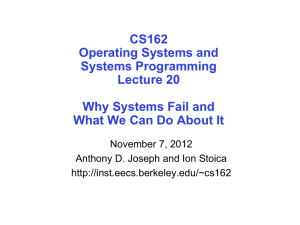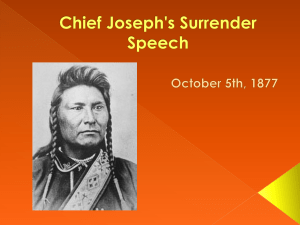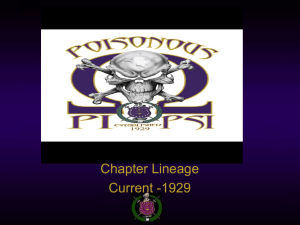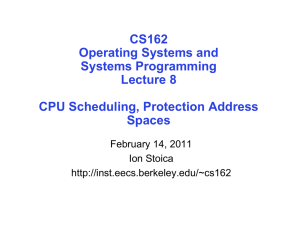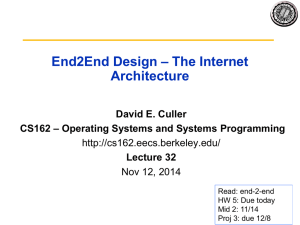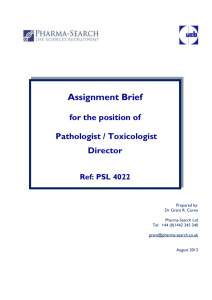ppt - EECS Instructional Support Group Home Page
advertisement
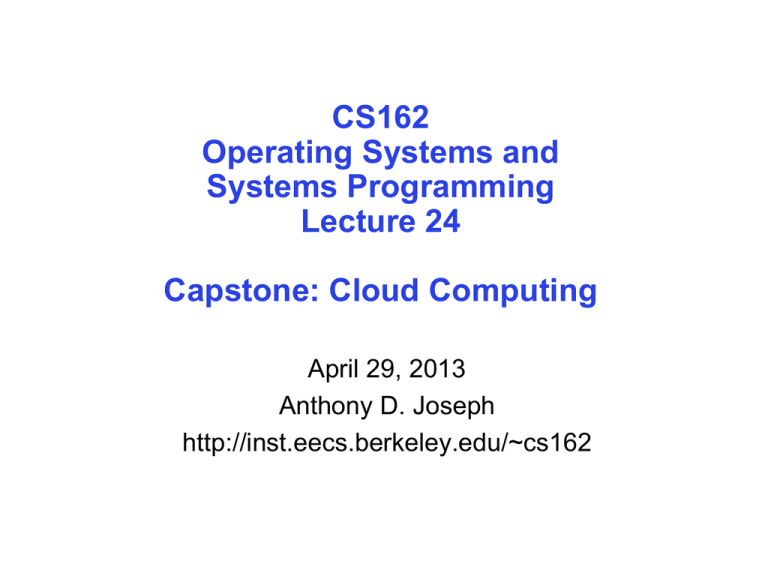
CS162
Operating Systems and
Systems Programming
Lecture 24
Capstone: Cloud Computing
April 29, 2013
Anthony D. Joseph
http://inst.eecs.berkeley.edu/~cs162
Goals for Today
• Distributed systems
• Cloud Computing programming paradigms
• Cloud Computing OS
Note: Some slides and/or pictures in the following are
adapted from slides Ali Ghodsi.
4/29/2013
Anthony D. Joseph CS162 ©UCB Spring 2013
24.2
Background of Cloud Computing
• 1990: Heyday of parallel computing, multi-processors
– 52% growth in performance per year!
• 2002: The thermal wall
– Speed (frequency) peaks,
but transistors keep
shrinking
• The Multicore revolution
– 15-20 years later than
predicted, we have hit
the performance wall
4/29/2013
Anthony D. Joseph CS162 ©UCB Spring 2013
24.3
At the same time…
• Amount of stored data is exploding…
4/29/2013
Anthony D. Joseph CS162 ©UCB Spring 2013
24.4
Data Deluge
• Billions of users connected through the net
– WWW, FB, twitter, cell phones, …
– 80% of the data on FB was produced last year
• Storage getting cheaper
– Store more data!
4/29/2013
Anthony D. Joseph CS162 ©UCB Spring 2013
24.5
Solving the Impedance Mismatch
• Computers not getting faster, and
we are drowning in data
– How to resolve the dilemma?
• Solution adopted by web-scale
companies
– Go massively distributed
and parallel
4/29/2013
Anthony D. Joseph CS162 ©UCB Spring 2013
24.6
Enter the World of Distributed Systems
• Distributed Systems/Computing
– Loosely coupled set of computers, communicating through
message passing, solving a common goal
• Distributed computing is challenging
– Dealing with partial failures (examples?)
– Dealing with asynchrony (examples?)
• Distributed Computing versus Parallel Computing?
– distributed computing=parallel computing + partial failures
4/29/2013
Anthony D. Joseph CS162 ©UCB Spring 2013
24.7
Dealing with Distribution
• We have seen several of the tools that help with
distributed programming
– Message Passing Interface (MPI)
– Distributed Shared Memory (DSM)
– Remote Procedure Calls (RPC)
• But, distributed programming is still very hard
– Programming for scale, fault-tolerance, consistency, …
4/29/2013
Anthony D. Joseph CS162 ©UCB Spring 2013
24.8
The Datacenter is the new Computer
• “Program” == Web search, email,
map/GIS, …
• “Computer” == 10,000’s
computers, storage, network
• Warehouse-sized facilities and
workloads
• Built from less reliable
components than traditional
datacenters
4/29/2013
Anthony D. Joseph CS162 ©UCB Spring 2013
24.9
Datacenter/Cloud Computing OS
• If the datacenter/cloud is the new computer
– What is its Operating System?
– Note that we are not talking about a host OS
4/29/2013
Anthony D. Joseph CS162 ©UCB Spring 2013
24.10
Classical Operating Systems
• Data sharing
– Inter-Process Communication, RPC, files, pipes, …
• Programming Abstractions
– Libraries (libc), system calls, …
• Multiplexing of resources
– Scheduling, virtual memory, file allocation/protection, …
4/29/2013
Anthony D. Joseph CS162 ©UCB Spring 2013
24.11
Datacenter/Cloud Operating System
• Data sharing
– Google File System, key/value stores
• Programming Abstractions
– Google MapReduce, PIG, Hive, Spark
• Multiplexing of resources
– Apache projects: Mesos, YARN (MRv2), ZooKeeper,
BookKeeper, …
4/29/2013
Anthony D. Joseph CS162 ©UCB Spring 2013
24.12
Google Cloud Infrastructure
• Google File System (GFS), 2003
– Distributed File System for entire
cluster
– Single namespace
• Google MapReduce (MR), 2004
– Runs queries/jobs on data
– Manages work distribution & faulttolerance
– Colocated with file system
• Apache open source versions Hadoop DFS and Hadoop MR
4/29/2013
Anthony D. Joseph CS162 ©UCB Spring 2013
24.13
GFS/HDFS Insights
• Petabyte storage
– Files split into large blocks (128 MB) and replicated across
several nodes
– Big blocks allow high throughput sequential reads/writes
• Data striped on hundreds/thousands of servers
– Scan 100 TB on 1 node @ 50 MB/s = 24 days
– Scan on 1000-node cluster = 35 minutes
4/29/2013
Anthony D. Joseph CS162 ©UCB Spring 2013
24.14
GFS/HDFS Insights (2)
• Failures will be the norm
– Mean time between failures for 1 node = 3 years
– Mean time between failures for 1000 nodes = 1 day
• Use commodity hardware
– Failures are the norm anyway, buy cheaper hardware
• No complicated consistency models
– Single writer, append-only data
4/29/2013
Anthony D. Joseph CS162 ©UCB Spring 2013
24.15
MapReduce Insights
• Restricted key-value model
– Same fine-grained operation (Map & Reduce)
repeated on big data
– Operations must be deterministic
– Operations must be idempotent/no side effects
– Only communication is through the shuffle
– Operation (Map & Reduce) output saved (on disk)
4/29/2013
Anthony D. Joseph CS162 ©UCB Spring 2013
24.16
What is MapReduce Used For?
• At Google:
– Index building for Google Search
– Article clustering for Google News
– Statistical machine translation
• At Yahoo!:
– Index building for Yahoo! Search
– Spam detection for Yahoo! Mail
• At Facebook:
– Data mining
– Ad optimization
– Spam detection
4/29/2013
Anthony D. Joseph CS162 ©UCB Spring 2013
24.17
MapReduce Pros
• Distribution is completely transparent
– Not a single line of distributed programming (ease, correctness)
• Automatic fault-tolerance
– Determinism enables running failed tasks somewhere else again
– Saved intermediate data enables just re-running failed reducers
• Automatic scaling
– As operations as side-effect free, they can be distributed to any
number of machines dynamically
• Automatic load-balancing
– Move tasks and speculatively execute duplicate copies of slow
tasks (stragglers)
4/29/2013
Anthony D. Joseph CS162 ©UCB Spring 2013
24.18
MapReduce Cons
• Restricted programming model
– Not always natural to express problems in this model
– Low-level coding necessary
– Little support for iterative jobs (lots of disk access)
– High-latency (batch processing)
• Addressed by follow-up research
– Pig and Hive for high-level coding
– Spark for iterative and low-latency jobs
4/29/2013
Anthony D. Joseph CS162 ©UCB Spring 2013
24.19
Pig
• High-level language:
– Expresses sequences of MapReduce jobs
– Provides relational (SQL) operators
(JOIN, GROUP BY, etc)
– Easy to plug in Java functions
• Started at Yahoo! Research
– Runs about 50% of Yahoo!’s jobs
4/29/2013
Anthony D. Joseph CS162 ©UCB Spring 2013
24.20
Example Problem
Given user data in one file,
and website data in another,
find the top 5 most visited
pages by users aged 18-25
Load
Users
Load Pages
Filter by age
Join on name
Group on url
Count clicks
Order by clicks
Take top 5
Example from http://wiki.apache.org/pig-data/attachments/PigTalksPapers/attachments/ApacheConEurope09.ppt
4/29/2013
Anthony D. Joseph CS162 ©UCB Spring 2013
24.21
In MapReduce
4/29/2013
Anthony D. Joseph CS162 ©UCB Spring 2013
24.22
Example from http://wiki.apache.org/pig-data/attachments/PigTalksPapers/attachments/ApacheConEurope09.ppt
In Pig Latin
Users
= load ‘users’ as (name, age);
Filtered = filter Users by
age >= 18 and age <= 25;
Pages
= load ‘pages’ as (user, url);
Joined
= join Filtered by name, Pages by user;
Grouped = group Joined by url;
Summed
= foreach Grouped generate group,
count(Joined) as clicks;
Sorted
= order Summed by clicks desc;
Top5
= limit Sorted 5;
store Top5 into ‘top5sites’;
Example from http://wiki.apache.org/pig-data/attachments/PigTalksPapers/attachments/ApacheConEurope09.ppt
4/29/2013
Anthony D. Joseph CS162 ©UCB Spring 2013
24.23
Translation to MapReduce
Notice how naturally the components of the job translate into Pig Latin.
Load
Users
Load Pages
Filter by age
Join on name
Job 1
Group on url
Job 2
Count clicks
Users = load …
Filtered = filter …
Pages = load …
Joined = join …
Grouped = group …
Summed = … count()…
Sorted = order …
Top5 = limit …
Order by clicks
Job 3
Take top 5
4/29/2013
Anthony D. Joseph CS162 ©UCB Spring 2013
24.24
Example from http://wiki.apache.org/pig-data/attachments/PigTalksPapers/attachments/ApacheConEurope09
Hive
• Relational database built on Hadoop
– Maintains table schemas
– SQL-like query language (which can also call Hadoop
Streaming scripts)
– Supports table partitioning,
complex data types, sampling,
some query optimization
• Developed at Facebook
– Used for many Facebook jobs
4/29/2013
Anthony D. Joseph CS162 ©UCB Spring 2013
24.25
Spark Motivation
Iterative job
4/29/2013
Query 2
Query 3
Interactive mining
Anthony D. Joseph CS162 ©UCB Spring 2013
Job 2
Query 1
Job 1
Stage 3
Stage 2
Stage 1
Complex jobs, interactive queries and online processing
all need one thing that MR lacks:
Efficient primitives for data sharing
…
Stream processing
24.26
Spark Motivation
Stage 3
Stage 2
Stage 1
Complex jobs, interactive queries and online processing
all need one thing that MR lacks:
Efficient primitives for data sharing
Query 1
Iterative job
4/29/2013
Interactive mining
Anthony D. Joseph CS162 ©UCB Spring 2013
Job 2
Job 1
Problem: in MR, the only way to share data
Query 2
across jobs is using stable storage …
Query 3
(e.g. file system)
slow!
Stream processing
24.27
Examples
HDFS
read
HDFS
write
HDFS
read
iter. 1
HDFS
write
. .
.
iter. 2
Input
HDFS
read
query 1
result 1
2
query is
2 gettingresult
Opportunity: DRAM
cheaper
use main memory for intermediate
result 3
query 3
Input
results instead of disks
. . .
4/29/2013
Anthony D. Joseph CS162 ©UCB Spring 2013
24.28
Goal: In-Memory Data Sharing
iter. 1
iter. 2
. .
.
Input
query 1
one-time
processing
Input
4/29/2013
query 2
query 3
Distributed
memory
. . .
10-100× Anthony
faster
than
D. Joseph
CS162 network
©UCB Spring 2013 and disk 24.29
Solution: Resilient Distributed
Datasets (RDDs)
• Partitioned collections of records that can be stored in
memory across the cluster
• Manipulated through a diverse set of transformations
(map, filter, join, etc)
• Fault recovery without costly replication
– Remember the series of transformations that built an
RDD (its lineage) to recompute lost data
• http://www.spark-project.org/
4/29/2013
Anthony D. Joseph CS162 ©UCB Spring 2013
24.30
Administrivia
• Project 4
– Design Doc due tonight (4/29) by 11:59pm, reviews Wed-Fri
– Code due next week Thu 4/9 by 11:59pm
• Final Exam Review
– Monday 5/6, 2-5pm in 100 Lewis Hall
• My RRR week office hours
– Monday 5/6, 1-2pm and Wednesday 5/8, 2-3pm
• CyberBunker.com 300Gb/s DDoS attack against Spamhaus
– 35 yr old Dutchman “S.K.” arrested in Spain on 4/26
– Was using van with “various antennas” as mobile office
4/29/2013
Anthony D. Joseph CS162 ©UCB Spring 2013
24.31
5min Break
4/29/2013
Anthony D. Joseph CS162 ©UCB Spring 2013
24.32
Datacenter Scheduling Problem
• Rapid innovation in datacenter computing frameworks
• No single framework optimal for all applications
• Want to run multiple frameworks in a single datacenter
– …to maximize utilization
– …to share data between frameworks
Pregel
Pig
CIEL
Dryad
4/29/2013
Percolator
Anthony D. Joseph CS162 ©UCB Spring 2013
24.33
Where We Want to Go
Today: static partitioning
Dynamic sharing
Hadoop
Pregel
Shared cluster
MPI
4/29/2013
Anthony D. Joseph CS162 ©UCB Spring 2013
24.34
Solution: Apache Mesos
• Mesos is a common resource sharing layer over which
diverse frameworks can run
Hadoop
Hadoop
…
Pregel
Mesos
…
Node Node
Pregel
Node Node
Node Node Node Node
• Run multiple instances of the same framework
– Isolate production and experimental jobs
– Run multiple versions of the framework concurrently
• Build specialized frameworks targeting particular
problem domains
4/29/2013
– Better performance than general-purpose abstractions
Anthony D. Joseph CS162 ©UCB Spring 2013
24.35
Mesos Goals
•
•
•
•
High utilization of resources
Support diverse frameworks (current & future)
Scalability to 10,000’s of nodes
Reliability in face of failures
http://incubator.apache.org/mesos/
Resulting design: Small microkernel-like
core that pushes scheduling
logic to frameworks
4/29/2013
Anthony D. Joseph CS162 ©UCB Spring 2013
24.36
Mesos Design Elements
•Fine-grained sharing:
– Allocation at the level of tasks within a job
– Improves utilization, latency, and data locality
•Resource offers:
– Simple, scalable application-controlled scheduling
mechanism
4/29/2013
Anthony D. Joseph CS162 ©UCB Spring 2013
24.37
Element 1: Fine-Grained
Sharing
Coarse-Grained Sharing (HPC):
Fine-Grained Sharing (Mesos):
Framework 1
Fw. 3
Fw. 1
Fw. 3
2
Fw. 2
Fw. 1
Fw. 2
Framework 2
Fw. 2
Fw. 3
Fw. 1
Fw. 3
Fw. 1
3
Fw. 2
Framework 3
Fw. 2
Fw. 1
Fw. 3
1
Fw. 2
Fw. 2
Fw. 3
Storage System (e.g. HDFS)
Storage System (e.g. HDFS)
+ Improved utilization, responsiveness, data locality
4/29/2013
Anthony D. Joseph CS162 ©UCB Spring 2013
24.38
Element 2: Resource Offers
•Option: Global scheduler
– Frameworks express needs in a specification language,
global scheduler matches them to resources
+ Can make optimal decisions
– Complex: language must support all framework
needs
– Difficult to scale and to make robust
– Future frameworks may have unanticipated needs
4/29/2013
Anthony D. Joseph CS162 ©UCB Spring 2013
24.39
Element 2: Resource Offers
• Mesos: Resource offers
– Offer available resources to frameworks, let them pick which
resources to use and which tasks to launch
+ Keeps Mesos simple, lets it support future frameworks
- Decentralized decisions might not be optimal
4/29/2013
Anthony D. Joseph CS162 ©UCB Spring 2013
24.40
Mesos Architecture
MPI job
Hadoop job
MPI
scheduler
Hadoop
scheduler
Mesos
master
Mesos slave
4/29/2013
Allocation
Resource
module
offer
Pick framework to
offer resources to
Mesos slave
MPI
executor
MPI
executor
task
task
Anthony D. Joseph CS162 ©UCB Spring 2013
24.41
Mesos Architecture
MPI job
Hadoop job
MPI
scheduler
Hadoop
scheduler
Resource offer =
Pick framework to
Mesos
Allocation
list of (node,
availableResources)
Resource
offer resources to
module
master
offer
E.g. { (node1, <2 CPUs, 4 GB>),
(node2, <3 CPUs, 2 GB>) }
Mesos slave
4/29/2013
Mesos slave
MPI
executor
MPI
executor
task
task
Anthony D. Joseph CS162 ©UCB Spring 2013
24.42
Mesos Architecture
MPI job
Hadoop job
MPI
scheduler
Hadoop
task
scheduler
Mesos
master
Mesos slave
4/29/2013
Pick framework to
offer resources to
Mesos slave
MPI
executor
task
Allocation
Resource
module
offer
Frameworkspecific
scheduling
MPI
Hadoop
executor executor
Launches and
isolates executors
task
Anthony D. Joseph CS162 ©UCB Spring 2013
24.43
Deployments
1,000’s of nodes running over a dozen
production services
Genomics researchers using Hadoop and
Spark on Mesos
Spark in use by Yahoo! Research
Spark for analytics
Hadoop and Spark used by machine
learning researchers
4/29/2013
Anthony D. Joseph CS162 ©UCB Spring 2013
24.44
Summary
• Cloud computing/datacenters are the new computer
– Emerging “Datacenter/Cloud Operating System”
appearing
• Pieces of the DC/Cloud OS
– High-throughput filesystems (GFS/HDFS)
– Job frameworks (MapReduce, Spark, Pregel)
– High-level query languages (Pig, Hive)
– Cluster scheduling (Apache Mesos)
4/29/2013
Anthony D. Joseph CS162 ©UCB Spring 2013
24.45

